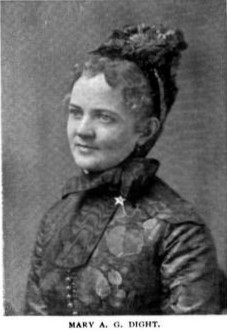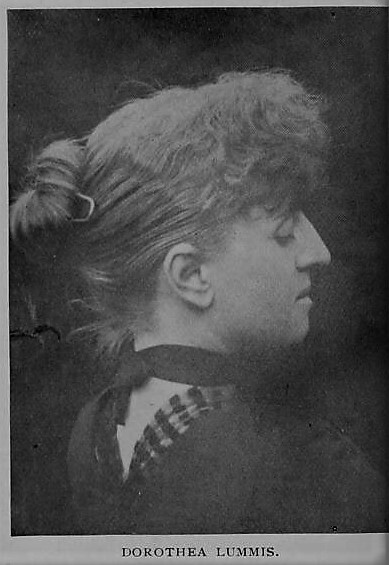November 5 - November 11
Women of the Week
Actress Lotta Crabtree, physician Mary A. G. Dight and physician Dorothea Lummis, are this week's Woman of the Week.
-
To learn about them by viewing their items, please click on their images.
-
To read their biographical sketches in A Woman of the Century, please click on the highlighted page number to the left of their images.
Born in New York City on November 7, 1847, Charlotte Crabtree, known as Lotta, spent her childhood in California. She began singing, dancing, and acting at a young age, going on tour in California while she was a teenager.
Lotta's debut in the city of her birth was at Niblo's Garden in 1864, and she quickly became a star. With her mother by her side, Lotta toured the country in 1866. This tour brought the young actress before audiences in Indianapolis, Pittsburgh, Baltimore, Washington, D.C., Buffalo, and Detroit. As her popularity continued to rise, Lotta performed in New York City, often in roles that, as her profile notes, were written for her.
Her fame spread through news of her performances and additional tours in 1873, 1890, and 1891.
During her later years, Lotta was a theatre owner, a vegetarian, and a supporter of suffrage and animal rights. She passed away in Boston, Massachusetts, on September 25, 1924, and was buried in Woodlawn Cemetery and Conservancy, Bronx, New York.
Mrs. Mary A. G.. Dight, also known as "Minnie," was born in Portsmouth, Ohio, on November 7, 1860. A talented musician, she attended the New England Conservatory of Music in Boston, Massachusetts. When she decided to change career paths to become a physician, Minnie attended the University of Michigan in Ann Arbor, Michigan.
After her graduation in 1884, she returned to Ohio. Minnie married Benjamin C. Trago on May 9, 1885, but their marriage was not a happy one. She left in 1886 for two years abroad, in Vienna and Paris, to hone her medical skills. Next, Minnie returned to Portsmouth and became president of the Hempstead Academy of Medicine. She married Dr. Charles F. Dight in 1892, and the couple lived in Faribault, Minnesota, Portsmouth, New Hampshire, New Orleans, Louisiana, Chicago, Illinois, Ann Arbor, Michigan, and Philadelphia, Pennsylvania, until their divorce in 1899. In addition to her work as a physician, Minnie was involved with social reform.
During the first decade of the twentieth century, Minnie returned to Vienna and Paris. When she came back to the United States in 1913, Minnie lived in New York City and had her summer cottage, Rocky Knoll, in Colebrook, New Hampshire. In 1921, Minnie planned to build a winter home in the Washington suburbs. She passed away in Colebrook on February 8, 1923.
Dorothea, whose birth name was Mary Dorothea Rhodes, was born on November 9, 1857, in Chillicothe, Ohio. After moving to Portsmouth, Ohio, and attending Portsmouth Female College at the age of sixteen, Dorothea, sometimes called Dolly, pursued her passion for music. Like Annie Fillmore Sheardown, Dorothea studied with Philadelphia's Emma Seiler, moving to that city to attend Seiler's Conservatory of Music.
Eventually, Dorothea moved to Boston to study with James O'Neil, who was affiliated with the New England Conservatory of Music. On September 9, 1880, Dorothea married Charles Fletcher Lummis, a young poet who had attended Harvard. Soon after, in 1881, she switched gears and decided to become a physician. Dorothea began studying at the Boston University School of Medicine, which had been founded in 1873.
After she graduated, Dorothea followed her husband to Los Angeles. In late November of 1884, she began advertising her services as a homeopathist in the city's new Hollenbeck Block. As Dorothea established her practice and her social network, she became affiliated with various philanthropic and professional organizations. In 1885, she was one of the first members of the Flower Festival Society, a group of women determined to build a Woman's Home in Los Angeles. Early in 1887, she was elected president of the Homeopathic Society of Los Angeles.
By 1890, Dorothea was a member of the Los Angeles Kennel Club, sometimes showing Amado, her mastiff. During the next year, when she and Charles divorced, Dorothea found time to pursue other passions. She contributed poems to Puck and became a member of the "S.M." Club of Los Angeles vocalists and musicians. In 1892, Dorothea was elected as one of the officers of the Friday Morning Club. Her love for her mastiff became part of her literary work in 1894, when Dorothea published the short story "Amado" in the Chicago Inter-Ocean. During her lifetime, she contributed to numerous periodicals.
In addition to her practice and her writing career, Dorothea took a serious interest in helping people in need. On August 18, 1895, the Los Angeles Herald published Dorothea's lengthy article "Caring for the Outcasts." She spent time in Chicago at Jane Addams's Hull House and later wrote an article about the settlement house which was published in the American Journal of Sociology in March of 1897. While there, she also came to know Earnest Carroll Moore, who became her second husband.
During the twentieth century, Dorothea continued her practice and was an active member of the California Club and the Friday Morning Club. Both Dorothea and Earnest spoke at the Friday Morning Club in June of 1910. They were guests of honor because Earnest had accepted a position at Yale, so the Moores were moving to New Haven.
Once she was in Connecticut, Dorothea took an active role promoting women's rights. She and Earnest both supported the idea of a woman president for a new women's college in that state. In March of 1913, she was a speaker at the Connecticut Woman Suffrage Association's referendum in Hartford. The next year, she took a vacation, sailing to the Mediterranean on the Fabra steamship liner Roma. By that time, Earnest's affiliation had changed to Harvard, so Dorothea had moved to Cambridge.
By 1920, the Moores were back in Los Angeles, where Earnest was a leader at UCLA. Dorothea passed away on March 4, 1942, and was buried in Forest Lawn Memorial Park in Glendale, California.



